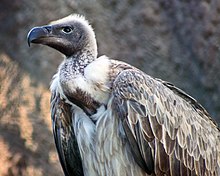| Revision as of 18:12, 24 October 2010 editLuckas-bot (talk | contribs)929,662 editsm robot Adding: sv:Vitryggad gam← Previous edit | Revision as of 20:21, 30 November 2010 edit undoEmausBot (talk | contribs)Bots, Template editors2,856,531 editsm robot Adding: az:Gyps africanusNext edit → | ||
| Line 48: | Line 48: | ||
| ] | ] | ||
| ] | |||
| ] | ] | ||
| ] | ] | ||
Revision as of 20:21, 30 November 2010
| White-backed Vulture | |
|---|---|
| File:Not a Common Visitor to Somerset.jpg | |
| Mature White-backed Vulture | |
| Conservation status | |
 Near Threatened (IUCN 3.1) | |
| Scientific classification | |
| Kingdom: | Animalia |
| Phylum: | Chordata |
| Class: | Aves |
| Order: | Accipitriformes |
| Family: | Accipitridae |
| Genus: | Gyps |
| Species: | G. africanus |
| Binomial name | |
| Gyps africanus (Salvadori, 1865) | |

The White-backed Vulture (Gyps africanus) is an Old World vulture in the family Accipitridae, which also includes eagles, kites, buzzards and hawks. It is closely related to the European Griffon Vulture, G. fulvus. Sometimes it is called African White-backed Vulture to distinguish it from the Oriental White-backed Vulture—nowadays usually called Indian White-rumped Vulture--to which it was formerly believed to be closely related.
The White-backed Vulture is a typical vulture, with only down feathers on the head and neck, very broad wings and short tail feathers. It has a white neck ruff. The adult’s whitish back contrasts with the otherwise dark plumage. Juveniles are largely dark. This is a medium-sized vulture; its body mass is 4.2 to 7.2 kilograms (9.3–15.9 lb), it is 94 cm (37 in) long and has a 218 cm (86 in) wingspan.

Like other vultures it is a scavenger, feeding mostly from carcasses of animals which it finds by soaring over savannah. It also takes scraps from human habitations. It often moves in flocks. It breeds in trees on the savannah of west and east Africa, laying one egg. The population is mostly resident.
As it is rarer than previously believed, its conservation status was reassessed from Least Concern to Near Threatened in the 2007 IUCN Red List.
Footnotes
- http://www.arkive.org/species/GES/birds/Gyps_africanus/more_info.html?section=factsAndStatus
- See BirdLife International (2007a. b).
References
- Template:IUCN2006
- BirdLife International (2007a): 2006-2007 Red List status changes. Retrieved 2007-AUG-26.
- BirdLife International (2007b): White-backed Vulture - BirdLife Species Factsheet. Retrieved 2007-AUG-26.
External links
- African White-backed Vulture videos on the Internet Bird Collection
| Old World vultures (subfamily: Aegypiinae) | |
|---|---|
| Genus | Species |
| Aegypius | |
| Gypaetus | |
| Gypohierax | |
| Gyps | |
| Necrosyrtes | |
| Neophron | |
| Sarcogyps | |
| Torgos | |
| Trigonoceps | |